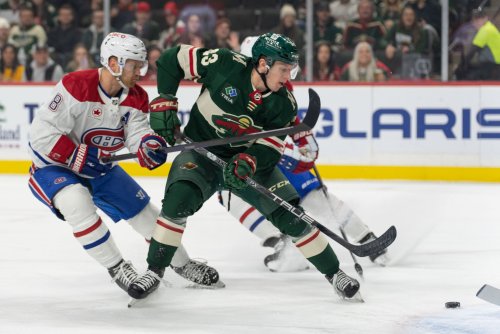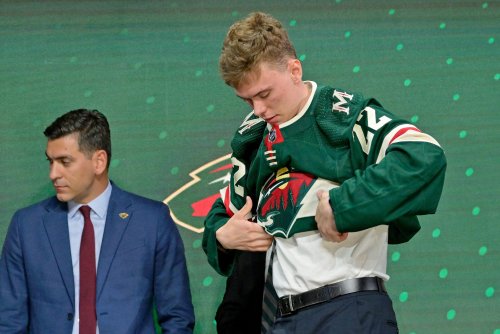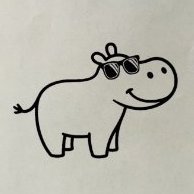
The Minnesota Wild are two games into the season. While they’ve both had results other than a big checkmark in the “W” column, there have been some good signs from those games. Neither Devan Dubnyk nor Alex Stalock were giving up lots of soft goals in their respective games (Dubnyk allowed one goal against the Detroit Red Wings he probably shouldn’t have), the bottom lines have been playing with some scoring punch, and the top line of Nino Niederreiter - Eric Staal - and Charlie Coyle has looked pretty good. They have used their size to their advantage and have repeatedly pinned the opposition into their own zone. The scoring hasn’t followed at the rate everyone would love to see, but they haven’t been held completely off the board either with Staal scoring a goal and Coyle recording an apple last game.
Of course, if the Wild want to start winning some games, if the top line’s scoring rate could accelerate, that would beneficial. Chowdah Charlie’s scoring has often seemed an all-or-nothing affair. He has the hands and strength to create his own opportunities and take complete charge of the game for stretches, but then goes quiet during painful slumps. The most popular prescription to Coyle’s snakebitten periods has been to “focus on playing with size”. Former head coach Mike Yeo gave dozens of quotes to that effect about the young right winger.
The origin of this narrative probably comes from “the Shift”.
If you watch it all the way through, Coyle singlehandedly maintains possession and leaves three different players lying flat on the ice by using his size and speed. He even gets an assist on the goal that follows as a result of his perserverance. It makes sense to argue that Coyle is playing his best when he focuses on playing big after watching plays like that.
But it doesn’t hold up. At least, there isn’t any evidence with the available statistics to suggest it.
I looked at Coyle’s gamelogs for the last three seasons and calculated the Pearson coefficient between hits and points, PIMs and points, hits and shots, and PIMs and shots. A Pearson coefficient is a measure of the linear correlation between two sets of numbers and it is stated on a range from -1 to 1. A coefficient of 1 would mean a perfect, positive linear relationship and a coefficient of -1 would mean a perfect, negative linear relationship. For example, if the correlation between hits and shots were 1.0, it would mean that for every hit Coyle delivers, he would also be taking a shot.
Here are the results of the last three years:
Almost all of the numbers are within +/-. 19 which means the linear relationship between the two sets of numbers is essentially nonexistent. A change in one factor has almost no impact on the other. One exception appears to exist in the numbers I ran, and that was for TOI and shots during the 2014-15 season. The correlation coefficient there was .25 which indicates a weak correlation exists between the number of shots Coyle took in a game and the TOI he received. That would make sense both in terms of more TOI means more time for Coyle to attempt shots and that Coyle would be trusted with more ice time in games when he’s getting off shots.
But let’s get back to the measures of physicality I assessed. I used hits and PIMs. This has some obvious drawbacks. Take the clip above. Coyle was undoubtedly playing a very physical brand of hockey during that shift, but as the puck carrier, he didn’t record a single hit. He also didn’t commit any penalties, so PIM didn’t capture his physicality during that shift either. Hits are determined at the scorekeeper’s discretion, so there’s also some ambiguity brought about by the human factor too. I bring all of this up to caveat my results as being based on limited and somewhat flawed data.
In an attempt to check my work, I took a look at Charlie’s hits during a scoring streak and a slump from last season. Coyle was on a pretty great kick from December 13 through February 12. He recorded hits at a rate of 1.18 per game. Starting on February 14, he didn’t score a single point for ten straight games, but his hits went up to 1.3 per game. He broke the slump with a one goal, one assist game in which he delivered one hit as well. The next two games he went scoreless, but delivered five hits and zero hits respectively.
There are obviously significant shortcomings in our ability to quantify physical hockey, and the evaluation presented here is far from sophisticated. Nevertheless, it does seem to indicate that the “play big and production will follow” narrative is too narrow to capture what actually makes Coyle tick. Underlying that idea is that when Coyle plays with confidence he is unafraid to deliver hits, attempt more plays, and take more shots is probably spot on.
Ultimately, the biggest conclusion that can be drawn from all of this is that until player and puck tracking is available, stats are woefully underdeveloped in terms of measuring a player’s physicality. As for Chowdah, hopefully Boudreau doesn’t try to boil his game down into getting hits first and letting the rest take care of itself. Coyle’s got a lot more to offer than just being a big body and the Wild are going to need all of it this season.
Think you could write a story like this? Hockey Wilderness wants you to develop your voice, find an audience, and we'll pay you to do it. Just fill out this form.








Recommended Comments
There are no comments to display.
Join the conversation
You can post now and register later. If you have an account, sign in now to post with your account.
Note: Your post will require moderator approval before it will be visible.